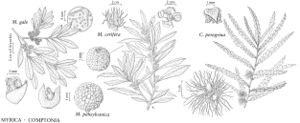Myricaceae
Shrubs or small trees, evergreen or deciduous, usually aromatic and resinous. Roots commonly with nitrogen-fixing nodules. Leaves alternate, simple or pinnatifid; stipules absent or present; petiole present. Leaf blade commonly with peltate, multicellular, glandular trichomes. Inflorescences axillary catkins; bracts present. Flowers usually unisexual, occasionally bisexual, staminate and pistillate flowers usually on different plants, occasionally on same plants; perianth absent. Staminate flowers subtended by solitary bract; stamens 2-14(-22), hypogynous or ± epigynous; filaments filiform, distinct or basally connate; anthers dorsifixed, 2-locular, extrorsely dehiscent by longitudinal slits. Pistillate flowers subtended by solitary bract, bracteoles present or absent, usually 2-4(-8); pistils 1, 2-carpellate, 1-locular; ovules 1, basal, erect; styles, if present, short; stigmas 2. Fruits drupaceous or nutlike, smooth or often covered with warty protuberances, these commonly with waxy coating; fruits sometimes enclosed by persistent, accrescent bracts and bracteoles. Seeds with little or no endosperm; embryo straight, with 2 plano-convex cotyledons.
Distribution
Widespread in temperate and subtropical regions.
Discussion
Genera 2-4, species ca. 50 (2 genera, 8 species in the flora).
Significant disagreement exists concerning the number of genera to be recognized in Myricaceae. Myrica in the broad sense is sometimes divided into three genera. Comptonia L'Héritier ex Aiton is often segregated on the basis of leaf type, presence of stipules, and the burlike fruits with 6-8 accrescent bracts and bracteoles. Morella Loureiro sometimes is elevated from its usual rank of subgenus to emphasize differences concerning position of the catkins, size of the staminate bracts, and appearance of the fruits (A. Chevalier 1901; J. R. Baird 1968). The real question is the appropriate rank at which recognition should be made (T. S. Elias 1971). I follow a traditional approach in recognizing just Myrica and Comptonia in North America.
Selected References
Illustrations
| Family ⠉ | Taxon | Illustrator ⠉ | |
|---|---|---|---|
 | Myricaceae Myricaceae Myricaceae Myricaceae | Myrica cerifera Comptonia peregrina Myrica gale Myrica pensylvanica | John Myers John Myers John Myers John Myers |
Key
| 1 | Leaves entire or serrate-denticulate, stipules absent; fruiting catkins short-cylindric; bracteoles 2-6, broadly ovate and equal to or shorter than fruits, or absent. | Myrica |
| 1 | Leaves pinnatifid, stipules present; fruiting catkins globose-ovoid; bracteoles 2 at anthesis, linear-subulate, accrescent, developing 4-8 tertiary bracteoles, these much exceeding fruit. | Comptonia |